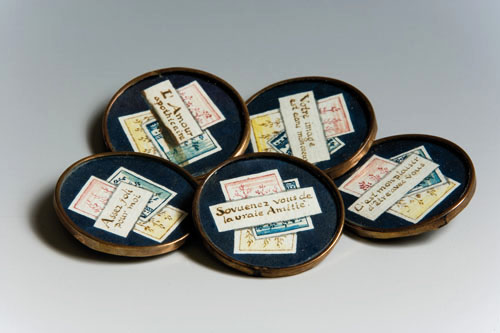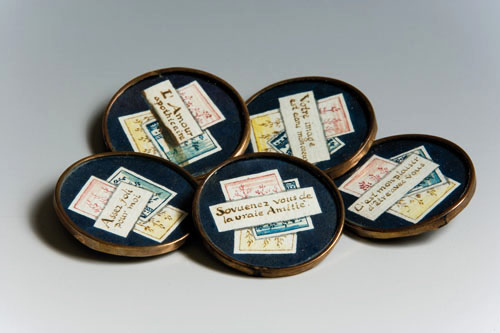When art sets out to deceive us, do we collude with just our eyes? The author visits an exhibit of trompe l’œil in Florence.
Try as they all might, few of the works on display at Art and Illusions—an exhibit at Florence’s Palazzo Strozzi featuring trompe l’œil from antiquity to the present—succeed in deceiving the eye. While attempts to lend a three-dimensional realism to two-dimensional surfaces abound, it’s not as if when I look at a first-century-BC Roman fresco depicting three birds hanging from a nail, a few feathers scattered below, I am tricked into perceiving depth where none exists. It is difficult, as I look at the fresco, to envisage birds such as these pecking at the grapes Pliny the Elder tells us Zeuxis painted. And as much verisimilitude as Pierre Gilou’s La citrouille (1973) offers, it takes several minutes of staring at the work—I must lull myself into an almost hypnotic state—to imagine that if I were to reach out and touch the object before me, I might feel the glossy surface of Gilou’s pumpkin rather than that of his painting.

My failure to be deceived—at least without some effort on my part—might stem from the works themselves (circumscribed as they are by the techniques devised and deployed during their artists’ eras), from the exhibit’s loose criteria (the curators struggle to make compelling distinctions between naturalism or realism or hyperrealism—none of which can really be said to set out to deceive—and trompe-l’œil), from the limitations of my own eyes and their capacity for depth perception (it would be difficult to be tricked into perceiving depth if there were a defect in my ability to perceive it), or from something else (my essential incredulity). Whatever renders Art and Illusions a little less visually cunning than the exhibit’s literature suggests, viewing this collection has led me to believe that the masters of trompe-l’œil execute their best feints when they deceive us into thinking it’s our eyes they intend to beguile.
Oliver Sacks writes in a 2006 New Yorker essay titled “Stereo Sue” of the sense of wonder experienced by Sue Barry, an amblyopic neuroscientist who, after fifty years without depth perception and without knowing she lacked it, managed to acquire through strenuous visual exercises the ability to perceive depth—an ability taken for granted by those of us who can see out of both eyes and don’t suffer from depth-occluding ocular dysfunctions. Even before she knew she lacked the ability to see in stereo Sue had wanted, as she put it quite simply in a letter to Sacks, “to see things in greater depth.”
While the women of eighteenth-century France flicked fans, finding their target and then demurely signaling their attraction… the men wore buttons like these for all the world—but especially for the objects of their desire—to see.
Given how attuned he is to profundity wherever it hides in our perceptual mechanisms, I can’t help but think that Sacks heard in Sue’s letter a wish to deepen not just her vision of the world but also her experience of it. He wonders whether the intensity of Sue’s desire to perceive depth had been so powerful as to make her believe that she did when technically she did not. When he presented her with a stereogram (that is, a two-dimensional image that appears to have depth), the layers of which were visible only when viewed through the lenses of the depth-endowing stereoscope through which she viewed the image, she still saw only a two-dimensional surface. The world was, to Sue, what computer-generated autostereograms of the sort that were popular when I was in college were to me. I remember having to strain to be able to discern the images’ illusions of depth. Likewise, Sue has to exercise her depth perception to experience it; in other words, she is not able to perceive depth every minute of every day—she first has to warm her eyes to it. She also, it seems, has to want to perceive it. When Sacks told Sue that the stereoscope ought to deepen the flat image, she perceived the image’s seven layers well enough to distinguish and order them. Apparently, she’d just needed a prompt.
Among the curious items included in Art and Illusions is a set of ten French tailcoat buttons dating from between 1770 and 1790. Depicted on the surface of each of the metal-based, paper-bodied buttons are loosely stacked cartes de visite rendered in watercolor and ink. Peeking out from the edges of the bottom three cartes—one yellow-, one blue-, and one red-hued—are images of treetops. Inscribed in ink on the top carte pictured on each button is a message, in French, from the man who wore the buttoned tailcoat to the person for whom he wore it. Waiting annoys me, reads one of the notes. Love me, it will cost you nothing, reads another. A few of the notes express simple feelings: It is my pleasure to be with you. Others suggest more complex thoughts or perhaps clues or desires: The perfume is inside.
What interested the exhibit’s curators in these buttons is the way the little cards depicted on each are arranged: one before the other, each set of four floating about as if in space. The curators describe the effect of the notes’ arrangement as lifelike. And perhaps if I were to stare at the buttons as I did at La citrouille and really try to perceive a depth of the sort the curators detect—if I were as open to suggestion, visually speaking, as Sacks’s Sue—I would see these notes floating in space, appearing one tree-lined message after another before their reader’s eyes as if in a dream. But I doubt it. No amount of staring would transform these notes into dreams of floating, flashing cartes de visite. That’s not the kind of trick these buttons turn.
Among the more startling—and fully deceiving—experiential elements of the exhibit is a rotating mask of Albert Einstein, the concave side of which looks convex because, as Gregory puts it, “a hollow face is so unlikely we cannot see it.”
I enjoy imagining the man who wore the exhibit’s buttons on his tailcoat. He would not have been alone in his approach to romance. The exhibition literature tells us that while the women of eighteenth-century France flicked fans, finding their target and then demurely signaling their attraction (only occasionally were messages written in the folds of a fan), the men wore buttons like these for all the world—but especially for the objects of their desire—to see. How naked this man must have felt in his long, buttoned tailcoat with its series of uncloaked messages. The love apothecary, reads another.
Looking at the buttons, I wonder what rituals of communication we have today that could hold a candle to these adornments, messages that are at once public and private. (A love-note-as-Facebook-status-update doesn’t quite compare.) I can’t imagine the thrill of wearing these little messages. And to be the person drawn in by them—to touch the buttons one by one, to read them up close and, maybe, push them through the slits of the man’s tailcoat. I suppose I am, in the end, taken for a ride—just not the one the curators scheduled. It is time to return to the exhibit.
Richard Gregory, an Art and Illusions collaborator and professor of neuropsychology at the University of Bristol, is interested in the role cues and clues play in vision. He and co-author Priscilla Heard explain the differences between the two concepts in their essay “Trumping the eyes.” Cues, they explain, stimulate the brain to perceive in particular ways: we are wired to see the small objects a picture depicts as more distant than its large objects. Clues work differently: they are based on past experience. Among the more startling—and fully deceiving—experiential elements of the exhibit is a rotating mask of Albert Einstein, the concave side of which looks convex because, as Gregory puts it, “a hollow face is so unlikely we cannot see it.” Like the birds said to have pecked at the grapes Zeuxis painted, we see what the mind’s eye would like to see. Even if it isn’t there.
That the Einstein mask depicts a face is enough for me to want to see one whose features project outward rather than inward. That the stereogram Sacks showed Sue was supposed to appear to have depth—even though it didn’t—was enough for Sue to perceive depth. That the eighteenth-century tailcoat buttons carry messages is enough to prompt my desire for the messages to have laid their bearer profoundly bare even if they were, when they were attached to a tailcoat, merely playful little buttons—just barely original enough to make their bearer vulnerable—and nothing else.
Suzanne Menghraj teaches writing in New York University’s Liberal Studies Program and is currently based at the university’s Florence, Italy, campus. “Seeing in Stereo” is the fifth in a six-part nonfiction series Menghraj is writing for Guernica with support from a Liberal Studies faculty grant. “The Infinite in the Infinitesimal,” the series’ fourth piece, appeared in Guernica in July 2009.
